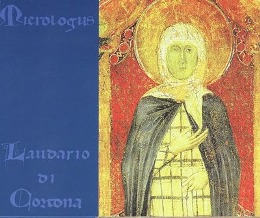Il Laudario di Cortona (1999)
Il Laudario di Cortona (1999)

CD-1: Laude della Vergine fol. 1-3v, Venite a laudare fol. 3v-5v, Lauda novella sia cantata fol. 5v-8v, Ave, donna santissima (lauda) fol. 8v-10, Madonna santa Maria (lauda) fol. 12v-14v, Ave, regina gloriosa (lauda) fol. 14v-17, Da ciel venne messo novello (lauda) fol. 17-19v, Altissima luce col grande splendore (lauda) fol. 19v-22, Fami cantar l'amor di la beata (lauda) fol. 22-24, O Maria, d'omelia (lauda) fol. 24-25v, Regina sovrana de gram pietade (lauda) fol. 25v-27, Ave, Dei genitrix (lauda) fol. 27-29, O Maria, Dei cella (lauda) fol. 29-32v, Ave, vergene gaudente (lauda) fol. 32v-34v, O divina virgo, flore (lauda) fol. 34v-36v, Salve, salve, Virgo pia (lauda) CD-2: Laude de Cristo fol. 39v-43v, Cristo è nato et humanato (lauda) fol. 43v-44v, Gloria 'n cielo e pace 'n terra (lauda) fol. 45-46, Stella nuova 'n fra la gente (lauda) fol. 46v-47v, Plangiamo quel crudel basciar[e] (lauda) fol. 47v-51, Ben è crudele e spietoso (lauda) fol. 51-53, De la crudel morte de Cristo (lauda) fol. 53-55, Dami conforto, Dio, et alegrança (lauda) fol. 55-57v, Onne homo ad alta voce (lauda) fol. 57v-60, Iesù Cristo glorioso (lauda) fol. 60-63, Laudiam la resurrectione fol. 72-82v, Troppo perde 'l tempo ki ben non t'ama (lauda) fol. 85v-88v, Oimè lasso e freddo lo mio core (lauda) fol. 117v-120, Amor dolçe sença pare (lauda) CD-3: Laude Dei Santi fol. 63-64v, Spiritu sancto, dolçe amore (lauda) fol. 64v-68, Spirito Sancto glorioso (lauda) fol. 68-69v, Spirito sancto, dà servire (lauda) fol. 70-72, Alta Trinità beata (lauda) fol. 82v-85, Stomme allegro et latioso (lauda) fol. 88v-90, Chi vol(e) lo mondo despreççare (lauda) fol. 90v-93, Laudar vollio per amore fol. 93-96, Sia laudato san Francesco fol. 96-100v, Ciascun ke fede sente (lauda) fol. 100v-110v, Magdalena degna da laudare fol. 38v-39v, Peccatrice, nominata (lauda) fol. 36v-38, Vergene donçella da Dio amata (lauda) fol. 110v-112v, L'alto prençe archangelo lucente (lauda) fol. 112v-114v, Faciamo laude a tutt'i sancti (lauda) fol. 114v-116, San Jovanni al mond'è nato (lauda) fol. 116-117v, Ogn'om canti novel canto (lauda) fol. 123-131v, Benedicti et llaudati fol. 131v-132v, Salutiam divotamente (lauda) Ensemble Micrologus
Patrizia Bovi, canto
Alessandro Quarta, canto
Gianni De Gennaro, canto
Goffredo degli Esposti, organo portativo
Gabriele Russo, viella
Adolfo Broegg, campane
The Laudario of Cortona is a collection of sixty-six 13th century religious songs, discovered in the archives of the Museum of the Etruscan Academy in 1876.
Although some 200 such ‘song books’ have come down to us, only 2 (the Magliabechiano Codex in the Italian National Library in Florence, and the Laudario di Cortona - Codex 91 of the Etruscan Academy) contain both the text and the music.
‘Laude’ or Lauds are songs of praise to the Virgin, to the Saints, or to Christ’s life. They were written in the vulgar tongue (here, in Italian rather than in the Latin used by the Church) by lay communities in the 12th and 13th centuries in reaction against the official church. St. Francis of Assisi played a part in the success of this popular movement: his Canticle of all Creatures is a hymn of praise written in Italian.
It is hardly surprising that the Laudario was found in Cortona given the city’s importance in the history of the Franciscan movement. St. Francis of Assisi stayed frequently at Le Celle monastery and dictated his will there. Brother Elias, the first Vicar General of the order and one of the principal diplomats of the period, is closely linked with Cortona and was responsible for the building of the large San Francesco church. Saint Margaret, the third great name of Franciscanism after Saints Francis and Clare (founder of the ‘Poor Clares’), is the patron saint of Cortona and is thought to be the inspiration for the Laudario.
The Lauds are sung at least twice a year in the life of Cortona: on Good Friday during the procession of the stations of the cross through the city and during the Santa Margarita festival in May.---home.scarlet.be
download: uploaded yandex 4shared mediafire solidfiles mega filecloudio nornar
Zmieniony (Wtorek, 18 Luty 2014 11:51)








